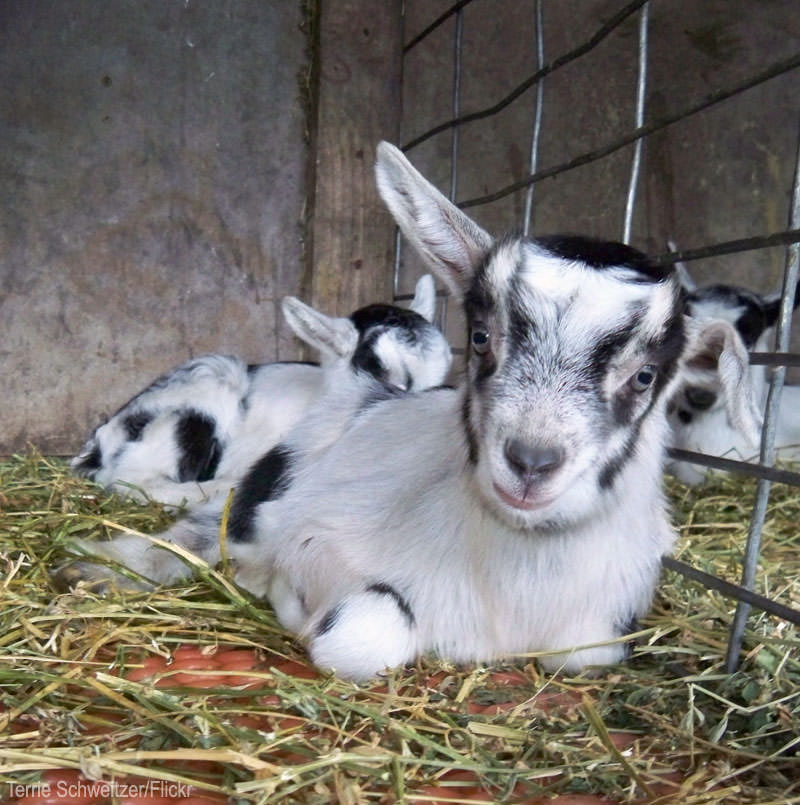
 Courtesy Terrie Schweitz/Flickr |
If God made anything cuter than the first baby goats, he must have kept it for Himself. Baby goats, called kids, are sweet, cuddly, cute and addictive to any farmer who keeps livestock. They’re also smart and mischievous, so if there’s trouble, they’ll find it. If you’re new to keeping baby goats, be forewarned: They’ll steal your heart and sometimes drive you crazy. Here are seven things to do to prepare yourself for kidding season.
1. Feed Your Pregnant Doe Well
If you have a bred doe, make sure she’s well-nourished before and after her delivery. Feeding pregnant goats is a complex subject, and North Carolina State University’s “Breeding and Kidding Management in the Goat Herd” is a great resource to learn more. Grain and high-quality pasture are good sources of feed, but you’ll want to pay attention to the goats Body Condition Score, especially during lactation. Incorrectly fed pre- and post-kidding does are prone to two serious, potentially fatal metabolic diseases: pregnancy toxemia and milk fever. Read about them and know how to recognize their symptoms should they arise.
2. Assemble a Kidding Kit
A comprehensive kidding kit includes bottle feeding and tube feeding supplies. Don’t skimp on these, and get them ahead of when your baby goats are due. The stores could be closed when your doe kids, and you’ll want to be prepared. We pack our kidding supplies in a chest-type cooler. It’s roomy, easy to tote to the barn and so much nicer to sit on than an overturned 5-gallon bucket. It holds:
- bottle of 7-percent iodine solution used to dip newborns’ navels; it’s a prescription item you get from your vet.
- shot glass to hold the iodine solution
- dull scissors to trim umbilical cords prior to dipping them in iodine (you want to crush the cord rather than make a clean cut); keep these scissors disinfected and stored in a sturdy zip-top bag.
- dental floss to tie off a bleeding umbilical cord, if needed
- digital veterinary thermometer
- two large squeeze bottles of lubricant; we like SuperLube from Premier1 Supplies
- Betadine Scrub for cleaning does prior to assisting
- sharp pocket knife
- hemostat
- adjustable rope halter
- two flashlights (one for backup in case the first fails)
- heavy-duty mechanics’ paper towels or two clean terrycloth towels
- a book or diagrams showing how to correct poorly positioned kids
3. Be On Kid Watch
Prepare yourself for your doe to kid. Have your vet or an experienced goat mentor on speed dial, and make sure you’re available when labor begins. Everything will probably go exactly as planned, but when the unexpected occurs, you being there to assist could mean the difference between life and death for your doe and her kids.
4. Kid-Proof the Goat Pen
Kids are bouncy, curious, and can hide and climb better than you can possibly believe. Block crevasses where they could get stuck, and make sure they can’t get wedged in gates or fences by blocking all crevices. Provide water for your doe in shallow receptacles; it’s possible for a frisky kid to hop into a deep bucket and drown.
5. Handle Your Kids
Working with baby goats helps to tame them. Kids are often frightened when you pick them up, so sit on the ground and cuddle them in your lap, scratching their chins and backs. Soon they’ll come running for attention.
By the same token, never roughhouse with male kids, especially those that will become pets, working goats or breeders. When you bond with kids, you become one of their herd. Goat play is often rough. If you shove little bucklings around in play or, worse, push on their heads and encourage them to push back, they grow up thinking you want to play that way. What’s cute when a goat weighs 15 pounds is not so sweet when he’s a 200-pound bruiser. It’s hard to correct play-aggression in adults, so don’t let the games get started.
6. Recognize Baby Goat Diseases
Know the symptoms of kidhood illnesses so that if a baby goat becomes ill, you’ll know how to treat the problem or you can take him to the vet. Coccidiosis, a very common problem with kids three weeks old and older, is highly contagious and potentially fatal, particularly in young kids. Other livestock and poultry species, especially chickens, are afflicted by coccidiosis, but the Eimeria protozoa that cause it are species-specific, meaning your kids can’t catch chicken or dog coccidiosis and vice versa. Symptoms include watery diarrhea, sometimes containing blood or mucus; listlessness; poor appetite; and abdominal pain. Without immediate, aggressive treatment, most kids die. If you suspect coccidiosis, consult your vet or mentor without delay. To prevent this, most goat keepers treat their kids with a coccidiosis-prevention protocol; ask your veterinarian which one to use.
7. Get Connected
Not everyone has access to a goat-savvy veterinarian, so be especially thankful if you do. If you don’t, consider joining one or more of the hundreds of goat-related Facebook groups and YahooGroups, where you can ask questions and benefit from the experience of hundreds of veteran goat keepers.
Goats are worlds of fun, and kids are way beyond darling. You’ll love your baby goats, especially if you get them off to a good start.
Get more baby-animal care tips from HobbyFarms.com:
- Protect Your Chicks Naturally from 7 Common Illnesses
- 15 Must-Have Items to Survive Lambing Season
- 3 Homegrown Treats for Farm Babies
- 6 Ways to Prepare Yourself and Your Cows for Calving




